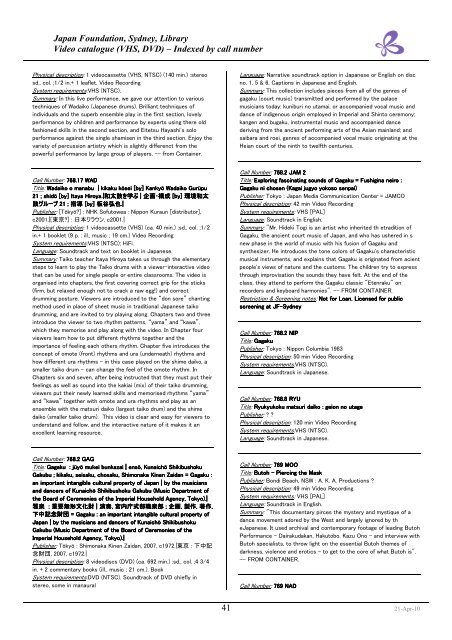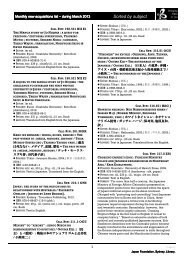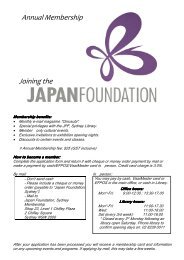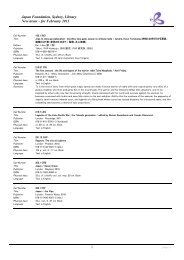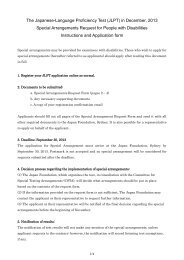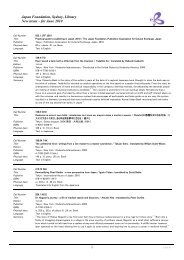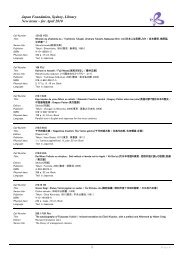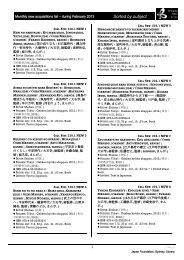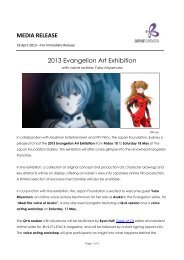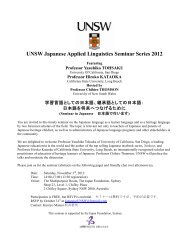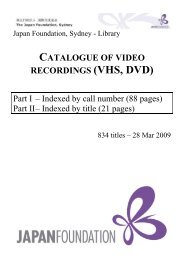catalogue of video recordings (vhs, dvd) - The Japan Foundation
catalogue of video recordings (vhs, dvd) - The Japan Foundation
catalogue of video recordings (vhs, dvd) - The Japan Foundation
Create successful ePaper yourself
Turn your PDF publications into a flip-book with our unique Google optimized e-Paper software.
<strong>Japan</strong> <strong>Foundation</strong>, Sydney, Library<br />
Video <strong>catalogue</strong> (VHS, DVD) – Indexed by call number<br />
Physical description: 1 <strong>video</strong>cassette (VHS, NTSC) (140 min.) :stereo<br />
sd., col. ;1/2 in.+ 1 leaflet. Video Recording<br />
System requirements:VHS (NTSC).<br />
Summary: In this live performance, we gave our attention to various<br />
techniques <strong>of</strong> Wadaiko (<strong>Japan</strong>ese drums). Brilliant techniques <strong>of</strong><br />
individuals and the superb ensemble play in the first section, lovely<br />
performance by children and performance by experts using there old<br />
fashioned skills in the second section, and Eitetsu Hayashi's solo<br />
performance against the single shamisen in the third section. Enjoy the<br />
variety <strong>of</strong> percussion artistry which is slightly differenct from the<br />
powerful performance by large group <strong>of</strong> players. -- from Container.<br />
Language: Narrative soundtrack option in <strong>Japan</strong>ese or English on disc<br />
no. 1, 5 & 6. Captions in <strong>Japan</strong>ese and English.<br />
Summary: This collection includes pieces from all <strong>of</strong> the genres <strong>of</strong><br />
gagaku (court music) transmitted and performed by the palace<br />
musicians today: kuniburi no utamai, or accompanied vocal music and<br />
dance <strong>of</strong> indigenous origin employed in Imperial and Shinto ceremony;<br />
kangen and bugaku, instrumental music and accompanied dance<br />
deriving from the ancient performing arts <strong>of</strong> the Asian mainland; and<br />
saibara and roei, genres <strong>of</strong> accompanied vocal music originating at the<br />
Heian court <strong>of</strong> the ninth to twelfth centuries.<br />
Call Number: 768.17 WAD<br />
Title: Wadaiko o manabu | kikaku kōsei [by] Kankyō Wadaiko Gurūpu<br />
21 ; shidō [by] Itaya Hiroya.| 和 太 鼓 を 学 ぶ | 企 画 ・ 構 成 [by] 環 境 和 太<br />
鼓 グループ 21 ; 指 導 [by] 板 谷 弘 也 .|<br />
Publisher: [Tōkyō?] : NHK S<strong>of</strong>utowea : Nippon Kuraun [distributor],<br />
c2001.|[ 東 京 ?] : 日 本 クラウン, c2001.|<br />
Physical description: 1 <strong>video</strong>cassette (VHS) (ca. 40 min.) :sd., col. ;1/2<br />
in.+ 1 booklet (9 p. : ill., music ; 19 cm.) Video Recording<br />
System requirements:VHS (NTSC); HiFi.<br />
Language: Soundtrack and text on booklet in <strong>Japan</strong>ese.<br />
Summary: Taiko teacher Itaya Hiroya takes us through the elementary<br />
steps to learn to play the Taiko drums with a viewer-interactive <strong>video</strong><br />
that can be used for single people or entire classrooms. <strong>The</strong> <strong>video</strong> is<br />
organised into chapters, the first covering correct grip for the sticks<br />
(firm, but relaxed enough not to crack a raw egg!) and correct<br />
drumming posture. Viewers are introduced to the “don sore” chanting<br />
method used in place <strong>of</strong> sheet music in traditional <strong>Japan</strong>ese taiko<br />
drumming, and are invited to try playing along. Chapters two and three<br />
introduce the viewer to two rhythm patterns, “yama” and “kawa”,<br />
which they memorise and play along with the <strong>video</strong>. In Chapter four<br />
viewers learn how to put different rhythms together and the<br />
importance <strong>of</strong> feeling each others rhythm. Chapter five introduces the<br />
concept <strong>of</strong> omote (front) rhythms and ura (underneath) rhythms and<br />
how different ura rhythms – in this case played on the shime daiko, a<br />
smaller taiko drum – can change the feel <strong>of</strong> the omote rhythm. In<br />
Chapters six and seven, after being instructed that they must put their<br />
feelings as well as sound into the kakiai (mix) <strong>of</strong> their taiko drumming,<br />
viewers put their newly learned skills and memorised rhythms “yama”<br />
and “kawa” together with omote and ura rhythms and play as an<br />
ensemble with the matsuri daiko (largest taiko drum) and the shime<br />
daiko (smaller taiko drum). This <strong>video</strong> is clear and easy for viewers to<br />
understand and follow, and the interactive nature <strong>of</strong> it makes it an<br />
excellent learning resource.<br />
Call Number: 768.2 JAM 2<br />
Title: Exploring fascinating sounds <strong>of</strong> Gagaku = Fushigina neiro :<br />
Gagaku ni chosen (Kagai jugyo yokoso senpai)<br />
Publisher: Tokyo : <strong>Japan</strong> Media Communication Center = JAMCO<br />
Physical description: 42 min Video Recording<br />
System requirements: VHS [PAL]<br />
Language: Soundtrack in English.<br />
Summary: "Mr. Hideki Togi is an artist who inherited th etradition <strong>of</strong><br />
Gagaku, the ancient court music <strong>of</strong> <strong>Japan</strong>, and who has ushered in s<br />
new phase in the world <strong>of</strong> music with his fusion <strong>of</strong> Gagaku and<br />
synthesizer. He introduces the tone colors <strong>of</strong> Gagaku's characteristic<br />
musical instruments, and explains that Gagaku is originated from acient<br />
people's views <strong>of</strong> nature and the customs. <strong>The</strong> children try to express<br />
through improvisation the sounds they have felt. At the end <strong>of</strong> the<br />
class, they attend to perform the Gagaku classic "Etenraku" on<br />
recorders and keyboard harmonies". -- FROM CONTAINER.<br />
Restriction & Screening notes: Not for Loan. Licensed for public<br />
screening at JF-Sydney<br />
Call Number: 768.2 NIP<br />
Title: Gagaku<br />
Publisher: Tokyo : Nippon Columbia 1983<br />
Physical description: 50 min Video Recording<br />
System requirements:VHS (NTSC).<br />
Language: Soundtrack in <strong>Japan</strong>ese.<br />
Call Number: 768.8 RYU<br />
Title: Ryukyukoku matsuri daiko : geion no utage<br />
Publisher: ? ?<br />
Physical description: 120 min Video Recording<br />
System requirements:VHS (NTSC).<br />
Language: Soundtrack in <strong>Japan</strong>ese.<br />
Call Number: 768.2 GAG<br />
Title: Gagaku : jūyō mukei bunkazai | ensō, Kunaichō Shikibushoku<br />
Gakubu ; kikaku, seisaku, chosaku, Shimonaka Kinen Zaidan = Gagaku :<br />
an important intangible cultural property <strong>of</strong> <strong>Japan</strong> | by the musicians<br />
and dancers <strong>of</strong> Kunaichō Shikibushoku Gakubu (Music Department <strong>of</strong><br />
the Board <strong>of</strong> Ceremonies <strong>of</strong> the Imperial Household Agency, Tokyo).|<br />
雅 楽 : 重 要 無 形 文 化 財 | 演 奏 , 宮 内 庁 式 部 職 楽 部 ; 企 画 , 製 作 , 著 作 ,<br />
下 中 記 念 財 団 = Gagaku : an important intangible cultural property <strong>of</strong><br />
<strong>Japan</strong> | by the musicians ians and dancers <strong>of</strong> Kunaichō Shikibushoku<br />
Gakubu (Music Department <strong>of</strong> the Board <strong>of</strong> Ceremonies <strong>of</strong> the<br />
Imperial Household Agency, Tokyo).|<br />
Publisher: Tōkyō : Shimonaka Kinen Zaidan, 2007, c1972.| 東 京 : 下 中 記<br />
念 財 団 , 2007, c1972.|<br />
Physical description: 8 <strong>video</strong>discs (DVD) (ca. 692 min.) :sd., col. ;4 3/4<br />
in. + 2 commentary books (ill., music ; 21 cm.). Book<br />
System requirements:DVD (NTSC). Soundtrack <strong>of</strong> DVD chiefly in<br />
stereo, some in manaural<br />
Call Number: 769 MOO<br />
Title: Butoh - Piercing the Mask<br />
Publisher: Bondi Beach, NSW : A. K. A. Productions ?<br />
Physical description: 49 min Video Recording<br />
System requirements: VHS [PAL]<br />
Language: Soundtrack in English.<br />
Summary: "This documentary pirces the mystery and mystique <strong>of</strong> a<br />
dance movement adored by the West and largely ignored by th<br />
e<strong>Japan</strong>ese. It used archival and contemporary footage <strong>of</strong> leading Butoh<br />
Performance - Dairakudakan, Hakutobo. Kazu Ono - and interview with<br />
Butoh specialists, to throw light on the essential Butoh themes <strong>of</strong><br />
darkness, violence and erotics - to get to the core <strong>of</strong> what Butoh is".<br />
-- FROM CONTAINER.<br />
Call Number: 769 NAD<br />
41 21-Apr-10


